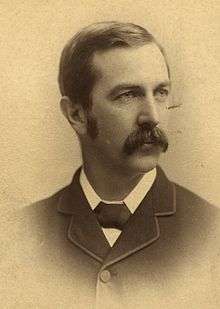Edward Willis Way

Dr. Edward Willis Way (ca.1847 – 28 September 1901), frequently written as "E. Willis Way", was a noted medical doctor and surgeon in the early days of the colony of South Australia.
History
Way was a son of Rev. James Way of the Bible Christian Church, and brother of Sir Samuel Way, the noted jurist, and left for Adelaide with his parents as a young child in the Anna Maria, arriving on 14 November 1850.[1] He was educated at AEI and St. Peter's College before studying medicine at Guy's Hospital and the University of Edinburgh.[2] He returned to Adelaide and soon had a lucrative practice, though pursuit of wealth was not his prime concern.[3] He was Medical Officer to the Stockade (later Yatala Labour Prison) and Health Officer to the Adelaide City Council.[4] He established his own private hospital (previously Miss Baker's Private Hospital?) in North Adelaide. He lectured in obstetrics at the University of Adelaide.
Much of his work at the North Adelaide Private Hospital was taken over by James Alexander Greer Hamilton (ca.1853 – 8 October 1925).[5]
Hospital controversy
Adelaide Hospital in the last decade of the 19th century was a dysfunctional workplace, riven with jealousies and intrigues. Around the beginning of 1896 the Board of Adelaide Hospital, of which Way was a member, made changes in the nursing structure,[6] one of the results being the promotion of Bessie Way, one of his daughters, to the position of Charge Nurse. Premier Kingston, who bore an antagonism towards Way, accused him of nepotism.[7] Nurse Way avoided the disagreeable situation by accepting a somewhat better position with the Kalgoorlie Hospital.[8] Kalgoorlie became the home of most, if not all, of his children.
Family
He was brother of Sir Samuel Way and close friend of brother-in-law the Hon. Dr. Allan Campbell.
He and his wife (ca.1850 – 20 October 1906) had a home on North Terrace, Adelaide and another residence at Strangways Terrace, North Adelaide. Among their children were:
- Inman Way, Resident Medical Officer, of Kalgoorlie Hospital.
- Eldest daughter Florence Jane Elizabeth "Bessie" Way (died 14 July 1949) married Arthur Vernon Harvey (1864 – 30 August 1901), mining investor of Kalgoorlie, and son of Arthur Harvey on 7 October 1896. He was killed at Devondale, South Africa in the South African War.[9] She married again, to Captain C(harles) Stanley Tratman of the 22nd Battalion, 8th Brigade, 1st AIF, on 19 October 1915. She was first matron of Kalgoorlie Hospital, then its secretary, later matron of Ru Rua Hospital, North Adelaide.[10]
- Second daughter Kate Isabel married William Arthur Irwin (ca.1860 – 12 October 1939), surveyor, on 18 April 1898, lived at South Perth.
- Third daughter Grace Mary "Gracie" Way married Henry Offley Irwin M.B., B.S. (ca.1871 – 31 January 1939) on 14 March 1898, lived at Boulder, Western Australia.
- Youngest daughter Marian married general practitioner (Arthur) Waldo Connelly (died 27 July 1946), of Boulder, Western Australia on 4 March 1903; later of Camberwell, Victoria.[11]
He died suddenly, while performing a surgical operation at his private hospital, and was buried at the North Road Cemetery. A parliamentary debate on matters critical of Chief Justice Way was postponed out of respect for the loss of his brother.[12]
References
- ↑ "Churches and Church Affairs". The Register. Adelaide: National Library of Australia. 5 April 1924. p. 6. Retrieved 21 September 2014.
- ↑ "Dr. E. Willis Way". South Australian Register. Adelaide: National Library of Australia. 6 July 1899. p. 5. Retrieved 21 September 2014.
- ↑ "Correspondence (M. S. Harper)". The Advertiser. Adelaide: National Library of Australia. 3 October 1901. p. 6. Retrieved 21 September 2014.
- ↑ "Death of Dr. E. W. Way". The Register. Adelaide: National Library of Australia. 30 September 1901. p. 5. Retrieved 17 September 2014.
- ↑ "Death of Dr. J A G Hamilton". The Advertiser. Adelaide: National Library of Australia. 9 October 1925. p. 13. Retrieved 21 September 2014.
- ↑ "A Ministerial Crisis". South Australian Register. Adelaide: National Library of Australia. 15 February 1896. p. 5. Retrieved 21 September 2014.
- ↑ "The Adelaide Hospital—The Premier and Miss Way's Appointments". South Australian Register. Adelaide: National Library of Australia. 29 July 1896. p. 6. Retrieved 21 September 2014.
- ↑ "Adelaide Hospital. Another Disagreement.". The Advertiser. Adelaide: National Library of Australia. 5 March 1896. p. 5. Retrieved 21 September 2014.
- ↑ "Personal". The Advertiser (Adelaide, SA : 1889 - 1931). Adelaide, SA: National Library of Australia. 1 October 1901. p. 5. Retrieved 5 September 2015.
- ↑ "Items of News". Kalgoorlie Miner. WA: National Library of Australia. 19 July 1949. p. 4. Retrieved 21 September 2014.
- ↑ "Personal". Kalgoorlie Miner. WA: National Library of Australia. 29 July 1946. p. 2. Retrieved 22 September 2014.
- ↑ "The Prisoner Andersen". The Advertiser. Adelaide: National Library of Australia. 3 October 1901. p. 8. Retrieved 21 September 2014.